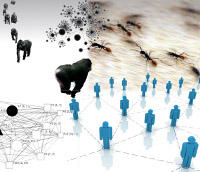Orateur
Dr
Cédric Sueur
(Institut Pluridisciplinaire Hubert Curien)
Description
Temporal and spatial structure of animal social groups is a fundamental topic in behavioural studies. Understanding how individuals interact can lead us to determine how genetic and cultural information spread within a population, to understand the evolution of animal sociality or to track disease transmission. In polygynous ungulates the social structure is influenced by sexual segregation and ecological factors partially influence ungulate’s social group. In this work we investigated the social network of males Alpine ibex (Capra ibex) living in Valsavarenche, in the Gran Paradiso National Park (Italy). They stay in group year-round except for the rutting season when they formed mixed-sex groups. Male Alpine ibex seems to live in a “fission-fusion” society as group composition varies often during the day and the seasons. The studied population was composed of about 65 males, 70% of which were marked and individually recognizable. Data on groups’ composition have been collected during 5 years (from 2008 to 2012) in the summer (from May to July), the period in which ibex showed the strongly sexual segregation. Our work explored group and individual measures with the purpose to better understand ibex social dynamics and detect if there are changes or not over a five year period in which ecological factors and anthropic disturb operated differently. Here we present the first results of social network analysis, which consist in the comparison of group-measures over the whole study period. Group size and diameter showed that groups’ composition or structure was stable, even if the bigger differences were among the first and the last year. However, density and transitivity increased during the five years whilst group centrality index decreased. We also studied changes of eigenvector centrality coefficients of the twenty common individuals over 5 years and this coefficient only decreased for individuals getting from adult to old whilst it stayed stable from juveniles to adults. We need now to understand ecological or social causes of these changes in the social network.
Auteur
Mlle
Claudia Canedoli
(Department of Earth and Environmental Science, University of Pavia, Pavia, Italy)
Co-auteurs
Dr
Achaz von Hardenberg
(Alpine Wildlife Research Centre, Gran Paradiso National Park, Italy)
Mlle
Alice Brambilla
(Department of Earth and Environmental Science, University of Pavia, Pavia, Italy)
Dr
Bruno Basano
(Alpine Wildlife Research Centre, Gran Paradiso National Park, Italy)
Dr
Cédric Sueur
(Institut Pluridisciplinaire Hubert Curien)
Prof.
Giuseppe Bogliani
(Department of Earth and Environmental Science, University of Pavia, Pavia, Italy)

